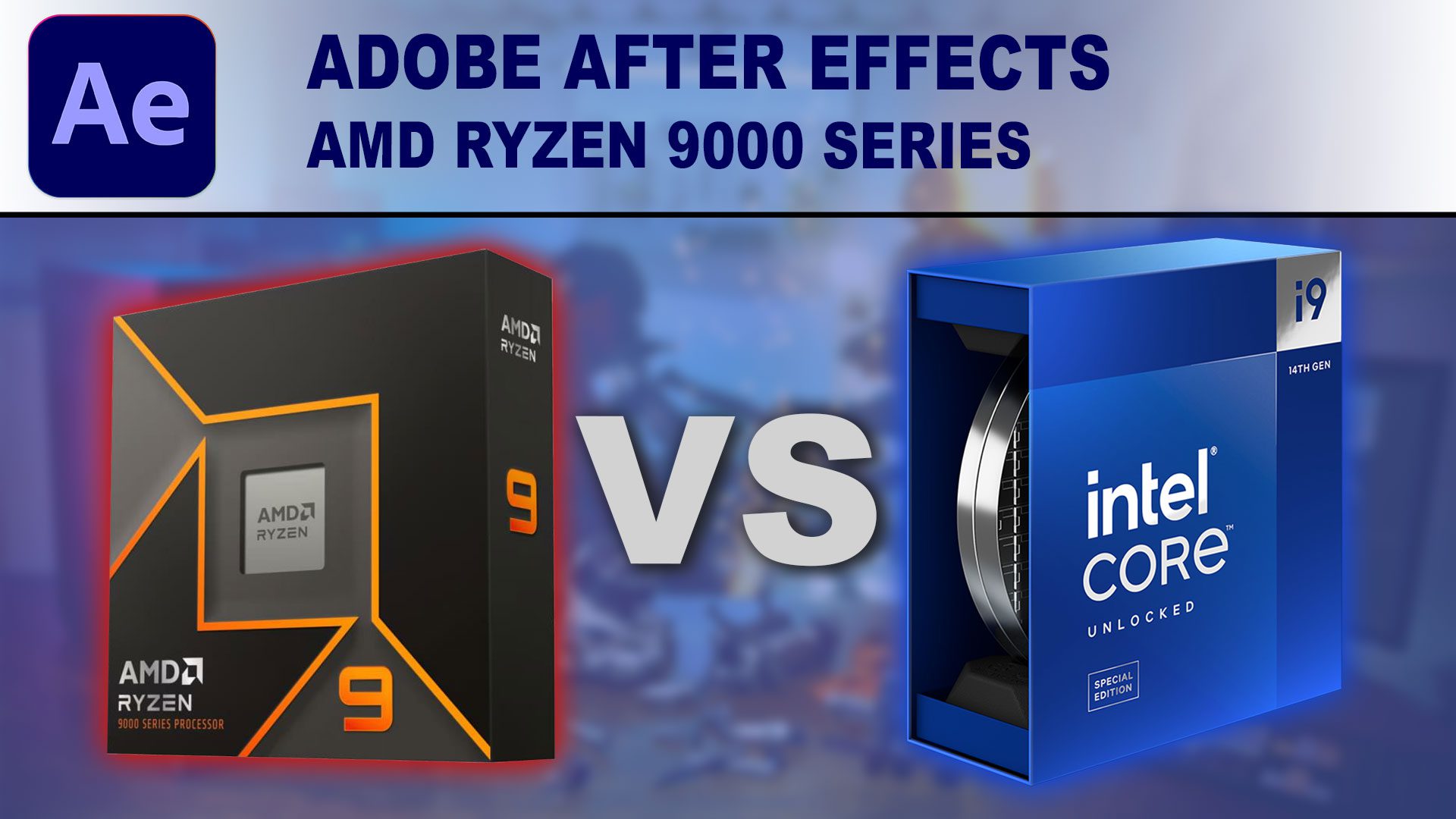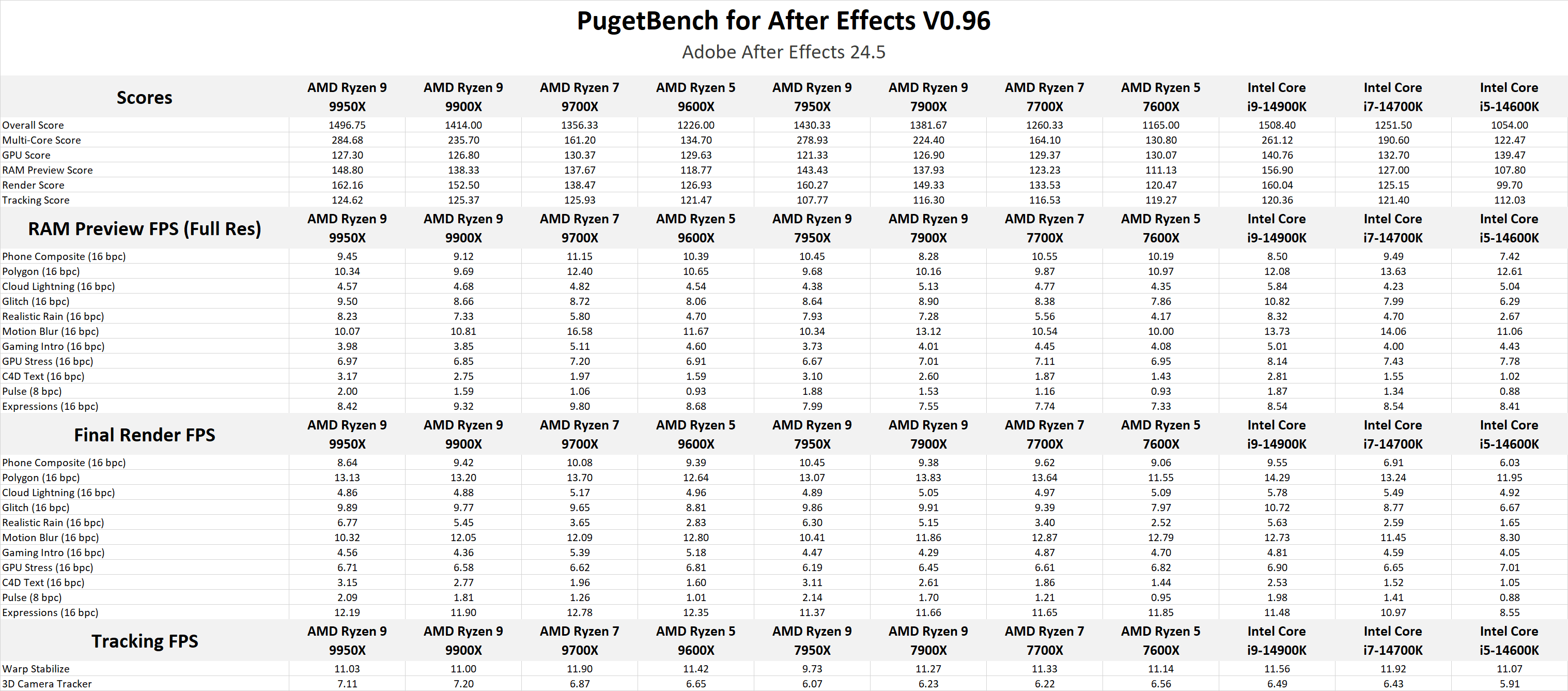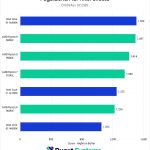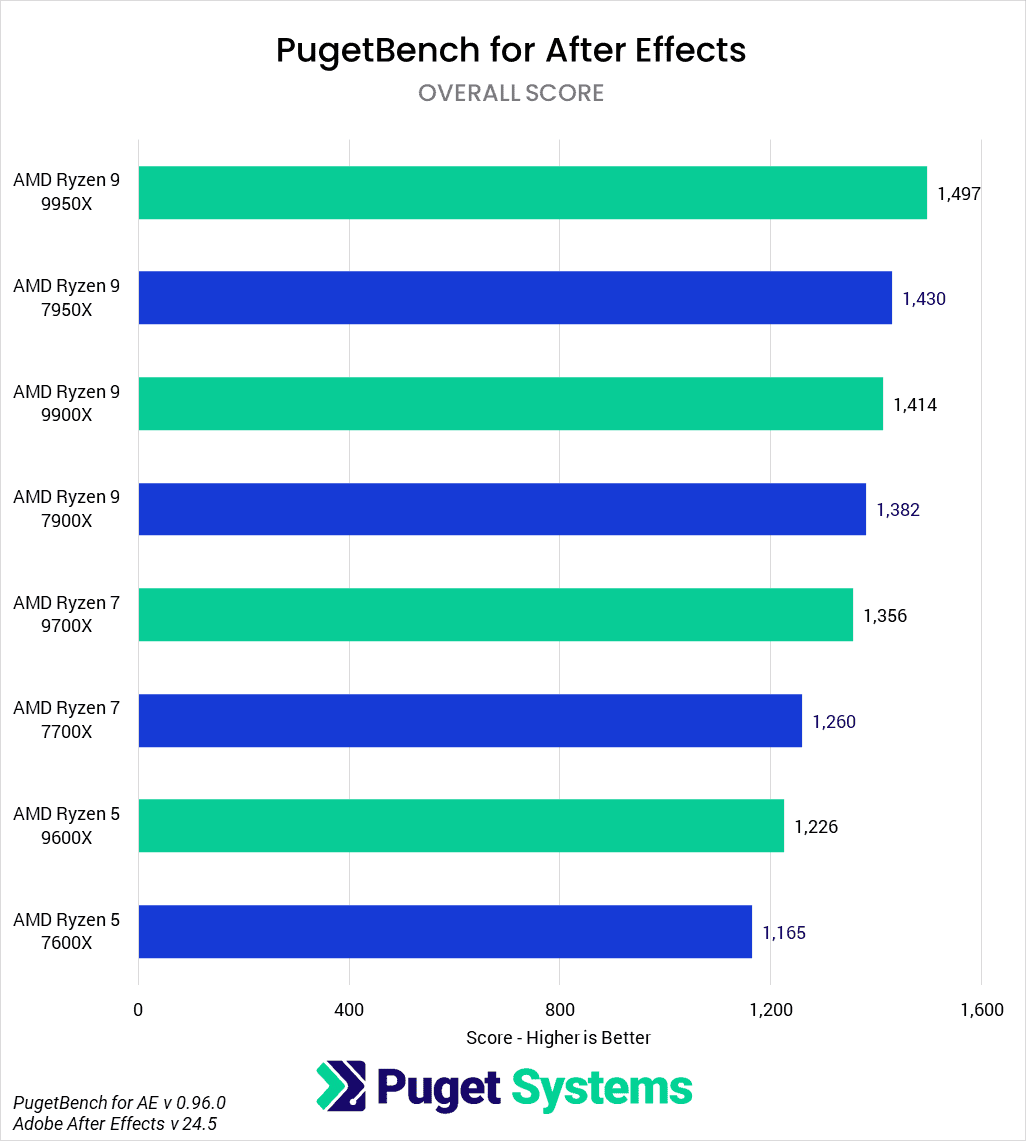Table of Contents
TL;DR: AMD Ryzen 9000 Series Processor Performance in After Effects
Overall, the new AMD Ryzen 9000 Series processors do fairly well in After Effects, especially for those on a tight budget. They are only slightly faster than the previous generation, mostly showing about a 5% performance uplift. Still, that is enough to put AMD Ryzen firmly in front of Intel Core at the lower end, with the Ryzen 5 9600X beating the Core i5 14600K by 16%, and the Ryzen 7 9700X beating the Core i7 14700K by 8%.
However, Intel and AMD are much closer for those looking for the absolute best performance in After Effects. Intel actually has a slight performance lead over the Ryzen 9 9900X, with the Core i9 14900K performing 6% faster. That isn’t much in the real world, and you may still opt to go with AMD for the $90 lower MSRP. The Ryzen 9 9950X does better in terms of performance, but is only on par with the Core i9 14900K, even though it has a $60 higher MSRP.
Introduction
AMD has recently launched its new Ryzen 9000 Series processors, which are a fairly minor refresh to its existing Ryzen 7000 processors. Utilizing the same AM5 socket and compatible with existing X670 motherboards, Ryzen 9000 is based on AMD’s new Zen 5 CPU architecture, which promises increased IPC (Instructions Per Clock), improved efficiency, and better memory support.
In this article, we will examine how these new processors perform specifically in Adobe After Effects. Intel has often held the lead in this type of application due to their high single-core performance, although AMD can be faster for some specific projects that can take better advantage of After Effects’ MFR (Multi-Frame Rendering) feature due to their higher number of full-performance cores. It will be interesting to see if AMD’s IPC and memory improvements are enough to put them ahead of Intel’s Core 14th Gen processors.
Because we will be examining so many CPUs, we will divide our analysis into Intel vs. AMD (AMD Ryzen 9000 vs. Intel Core 14th Gen) and performance versus the previous generation (AMD Ryzen 9000 vs. AMD Ryzen 7000).

If you want to read more about the new AMD Ryzen 9000 CPUs and what distinguishes them from the previous generation, we recommend checking out our main AMD Ryzen 9000 Series Content Creation Review article. That post includes more detailed information on the CPU specifications and MSRP and an overview of testing results for a range of other applications, including Photoshop, DaVinci Resolve, Premiere Pro, Unreal Engine, Cinema 4D, Blender, and V-Ray.
Raw Benchmark Data
We design our benchmarks to cover many workflows and tasks to provide a balanced look at the application and its hardware interactions. However, many users have more specialized workflows. Recognizing this, we like to provide individual results for benchmarks as well. If a specific area comprises most of your work, examining those results will give a more accurate understanding of the performance disparities between components.

AMD Ryzen 9000 vs Intel Core 14th Gen for Adobe After Effects
If you look at our previous consumer-level After Effects CPU article (Adobe After Effects: Intel Core 14th Gen vs AMD Ryzen 7000), Intel held about a 10-15% performance over AMD. Since then, we have had various driver and BIOS updates, as well as a major update to After Effects (24.0). With those changes and the improvements AMD has made to the Ryzen 9000 Series, Intel is still slightly ahead overall at the top end, but AMD has made some great strides, especially for those that are on a tighter budget.
It can be a bit tough when comparing Intel and AMD CPU models since they do not have models with the same MSRP. However, the closest matches are:
- AMD Ryzen 9 9950X ($650) vs. Intel Core i9 14900K ($590)
- AMD Ryzen 9 9900X ($500) vs. Intel Core i9 14900K ($590)
- AMD Ryzen 7 9700X ($360) vs. Intel Core i7 14700K ($410)
- AMD Ryzen 5 9600X ($280) vs. Intel Core i5 14600K ($320)
We do want to point out that in these comparisons, AMD is always a bit less expensive than Intel in terms of price, other than the 9950X vs 14900K. They also have a lower power draw, meaning less heat output and noise. Because of that, if things are close, AMD actually has the advantage.
Starting at the bottom of the stack, the AMD Ryzen 5 9600X has the strongest showing from AMD, coming in at 16% faster overall than the Intel Core i5 14600K. It does particularly when rendering, but with the exception of the GPU tests (which tend to favor Intel-based platforms), it was always at least around 10% faster than the 14600K.
The Ryzen 7 9700X also does well, coming in about 8% ahead of the Intel Core i7 14700K. However, it does struggle in a few areas, with the 14700K actually being 15% faster in heavier projects where the Multi-Frame Rendering (MFR) feature comes more into play. That isn’t likely to be a major factor at this budget level, however, so AMD once again has a healthy lead over Intel at this price point.
Moving up to the Ryzen 9 models, AMD falters a bit. The Ryzen 9 9900X ended up scoring about 5% behind the Intel Core i9 14900K, although given its lower MSRP and TDP, we would call it a wash between Intel and AMD. At the top end, the Ryzen 9 9950X is basically on par with the 14900K, only with slightly stronger performance for heavier After Effects projects. As the 9950X is higher cost than the 14900K, we give Intel the win here.
Overall, the AMD Ryzen 5 9600X and Ryzen 7 9700X are both terrific options for those on a budget and can give great performance over Intel’s comparable Intel Core i5 14600K and Core i7 14700K. For those looking for the highest performance, however, the Core i9 14900K gives Intel the overall win, although it is close enough that it can be very easy to justify going with AMD depending on your exact use case.
AMD Ryzen 9000 vs AMD Ryzen 7000 for Adobe After Effects
When comparing the new AMD Ryzen 9000 Series to the previous Ryzen 7000 Series, you need to be aware that AMD technically introduced a small price drop with the new CPUs. However, since AMD CPUs are often on sale, the new models will actually be a bit more expensive in most cases. That will even out over time as sales start to appear for these new processors, but for now, Ryzen 9000 will likely have a small price premium over the older 7000 models.
Rather than going through the models one by one, we are going to simply say that in the majority of cases, the new Ryzen 9000 CPUs are only a small amount (5% or less) faster than the previous generation. The only exception is the Ryzen 7 9700X, which came in at 8% faster overall than the Ryzen 7 7700X. Given the small gen-over-gen performance gains, it is unlikely that anyone with an existing Ryzen 7000 processor is going to be looking at upgrading to these new models.
How Well Do the AMD Ryzen 9000 CPUs Perform in After Effects?
Overall, the new AMD Ryzen 9000 Series processors do fairly well in After Effects. Compared to the previous Ryzen 7000 generation, they are only slightly faster, mostly showing about a 5% performance uplift. Still, that is enough to put AMD Ryzen firmly in front of Intel Core at the lower end, with the Ryzen 5 9600X beating the Core i5 14600K by 16%, and the Ryzen 7 9700X beating the Core i7 14700K by 8%.
However, Intel and AMD are much closer for those looking for the absolute best performance in After Effects. Intel actually has a slight performance lead over the Ryzen 9 9900X, with the Core i9 14900K performing 6% faster. That isn’t much in the real world, and you may still opt to go with AMD for the $90 lower MSRP. The Ryzen 9 9950X does better in terms of performance, but since After Effects isn’t particularly well threaded in most cases, it is only on par with the Core i9 14900K, even though it has a $60 higher MSRP.
Every application uniquely utilizes hardware, so our results here don’t necessarily translate to any other application. Our focus in this article centers specifically on AMD Ryzen 9000 Series performance in Adobe After Effects. However, we recommend checking out our AMD Ryzen 9000 Series Content Creation Review article, which includes a broad overview of results for several different applications. If you use other software packages, it also has links to our in-depth testing articles for content creation: Photoshop, Premiere Pro, DaVinci Resolve, After Effects, Unreal Engine, Cinema 4D, Blender, and V-Ray.
Finding the perfect workstation doesn’t have to be complicated. Explore our solutions page for a curated selection of recommended systems for a multitude of applications and workflows, or visit our custom configuration page if you already know the ideal hardware for your needs. If you need assistance with tailoring a system to a unique workflow or have any other questions, we encourage you to reach out to our dedicated technology consultants.


















